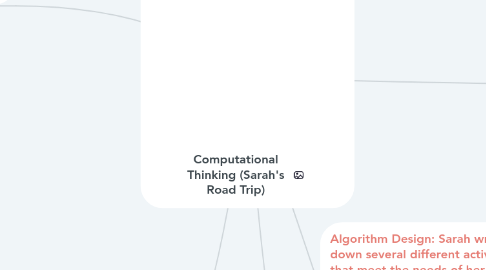Computational Thinking (Sarah's Road Trip)
by Kasteene Harris

1. Pattern Recognition: As Sarah searches the internet, she notices a pattern. Swimming holes, hiking, and fishing spots throughout Texas tend to stay together or can be found on the same path. Many of these same routes allow travelers to visit historical landmarks, battle grounds, and museums along or close to swimming holes, hiking, and fishing spots.
1.1. Rationale: Abstraction involves generalizing and transferring the problem solving process to similar problems. (Yadav, Hong & Stephenson, 2016) Results of the internet search showed that swimming and fishing holes, along with hiking trails are grouped together, with historical stops being close to, or along the route to be taken.
2. Decomposition (breakdown): First, Sarah will need to take her overall problem and break it down into more manageable parts. In this instance, Sarah needs to first search the internet for routes, or towns, that involve swimming, hiking/fishing, and a museum or historical stop.
2.1. Rationale: “Decomposition, where we take a large problem and we break it down into smaller pieces.” (Ornduff, Barcay & Pack, 2012) The internet was searched to find routes, or towns, that offered each of the activities within close proximity of each other, or at least in a feasible route.
3. Problem Statement: Sarah and her three children (Emily, Michael, and Ty) would like to take a road trip through Texas this summer. Each child likes different family group activities. Emily would like to stop somewhere to swim and relax, while Michael would like outdoor activities such as hiking, or fishing. Ty does not like to be outside, and would rather visit a museum or watch a movie. Sarah would like to be able to plan activities that each of her children would be excited about, without going out of their way while traveling. But How?
4. Ornduff, T., Barcay, D., & Pack, J. (2012). Solving Problems at Google Using Computational Thinking. Retrieved from Solving Problems at Google Using Computational Thinking Yadav, A., Hong, H., & Stephenson, C. (2016). Computational Thinking for All: Pedagogical Approaches to Embedding 21st Century Problem Solving in K-12 Classrooms. Techtrends, 60(6), 565-568. doi: 10.1007/s11528-016-0087-7
4.1. Reference
5. Algorithm Design: Sarah writes down several different activities that meet the needs of her children through Texas that she found on the internet. She uses these activities and their locations to map out her travel route for their family road trip. By planning her activities first and using preplanned locations Sarah is able to keep her travel route on a functionable path without having to go out of her way to please each child.
5.1. Rationale: An algorithm (much like a recipe) is a step-by-step series of instructions. (Yadav, Hong & Stephenson, 2016) Once the places of interest had been identified on the map, it was possible to lay out the route, so that the trip could be accomplished in the most economical way possible. This allows them all to know what activity they will be doing on each leg of the trip.
6. Abstraction: Sarah realizes that it is possible to find ways that her whole family can be happy and enjoy their summer road trip together. For example, if she were to take other road trips, but with more people and interests, she would still be able to use the same method to plan her trips, allowing them to be exciting, functionable and pleasing to all.
6.1. Rationale: automation involves using digital and simulation tools to mechanize problem solutions. (Yadav, Hong & Stephenson, 2016) The process she followed to map the route for the trip, can be used over and over again to map out routes for other trips, with other activities.


